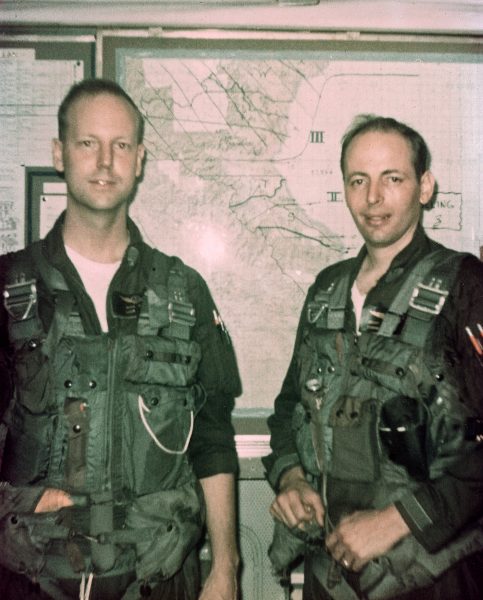LCDR Mike Hall & CDR Jerry Zacharias, VA-75
February 1968, USS Kitty Hawk (CVA-63)
A Trip Downtown
I was the Commanding Officer of Attack Squadron 75, better known as VA-75 or “The Sunday Punchers.” We were part of Air Wing ELEVEN on USS Kitty Hawk (CVA-63) flying strikes from a place called “Yankee Station” in the Gulf of Tonkin into the Northeast sector of North Vietnam in support of Operation Rolling Thunder. We were deployed in the Gulf from December 1967 to June 1968.
We normally flew strikes for a 20-day line-period and then got a few days of rest and relaxation (R&R) in port at Cubi Point in the Philippines. However, the Navy ship USS Pueblo had been captured by the North Koreans and our relief, the USS Enterprise (CVAN-65), was up in Korean waters. So, we ended up flying 61 continuous days of strikes until Enterprise finally returned to Yankee station on 22 February 1968.
As soon as Enterprise arrived, Kitty Hawk departed for some well-deserved R&R. As we approached the Philippines and everyone was preparing for liberty ashore, a message came in from Commander Task Force 77 that ordered a strike against the Hanoi port facilities, right in downtown Hanoi. Because Enterprise had only been on station for one-day, the message ordered a joint-strike from Enterprise. So we launched two aircraft and landed aboard Enterprise that afternoon. We did mission planning for the strike with the aircrews from the A-6 squadron on Enterprise, VA-35. We had dinner that evening and hit the sack early. Reveille was at 12:30. We put on our flight gear and headed for the VA-35 ready room where we re-briefed the mission. We manned airplanes at 01:30 and launched at 02:00.
Unfortunately, the Enterprise A-6 squadron ground crew aligned my A-6’s inertial system in the Polar Mode. You only use the Polar Mode above 65 degrees North or South latitude. We happened to be at 19 degrees North Latitude. As we rolled down the catapult track my primary attitude reference (The Visual Display Indicator or VDI) turned upside down and I climbed out on smaller standby gyro. I called the Enterprise and told them that my inertial platform tumbled on the catapult shot. They replied “Roger.” As planned, I continued climbing overhead Enterprise to 10,000 feet to join the rest of the flight topping off their fuel from an A-3 tanker for the long flight to Hanoi. Because of my system problems, I was the last plane in line to tank. Approaching the tanker to plugin, the tanker had electrical failure and was unable to transfer fuel. This is the second thing that happened in the first ten minutes of this flight and I’m beginning to think – this wasn’t going to be my night. So with no primary attitude reference and no extra fuel, I discussed the situation with my Bombardier/Navigator (B/N), LCDR Mike Hall and we decided to try an airborne alignment of the inertial system. That meant flying straight and level with minimum turns for about 25 minutes to see if we could get an alignment. After 22 minutes, we got a ready-light on the inertial platform. I checked the fuel and it was going to be close, but I thought we had enough fuel to complete the mission and we headed into mountains southwest of Hanoi. As we descended out of the mountains into the flat lands of the Red River delta I could hear the Russian Fansong surface-to-air missile radars start tracking us. I leveled off at 200 feet and proceeded inbound at 350 knots (407 miles per hour). In a minute or so my missile warning receiver started blaring and I spotted two missiles at 11 o’clock position coming toward us. I told my B/N, I was going down to 100 feet. At 100 feet, even though it was pitch black outside, I could see objects wizzzzing by my left windscreen and I thought to myself, those must be farm houses. Just then, my B/N said “you are level at 50-feet.” I said, Roger, going back to 100 feet. I was now at full-throttle and accelerating to 450 knots (517 mph) and watched those two missiles approaching us. When I thought that they were close enough, I dropped chaff, rolled the aircraft to 89 degrees right bank and pulled a 5 to 6G climbing turn. One missile went through the space that we just vacated and the second missile exploded under the aircraft, buffeting it violently, and put a small hole in our left wing.
One missile went through the space that we just vacated and the second missile exploded under the aircraft, buffeting it violently, and put a small hole in our left wing.
My B/N then said “your heading for the target is 354 degrees” and I rolled out on that heading to the target. We were now about 22 minutes behind the rest of the strike group. As we approached the target everyone in Hanoi was awake and shooting. There was so much anti-aircraft fire going up I could see the outline of the Red River flowing thru Hanoi and knew we were right in track for the target. At 4:20 in the morning, I dropped 18-500 pound MK-36 Destructors (magnetic aerial mines) on the port facilities and egressed right over center of the Hanoi at 400 feet, waking the heavy sleepers. On the outbound heading I would pick two AAA sites that were firing and flew right in between them. As soon as they passed, I picked two more AAA sites that were firing and flew right in between them. I continued this until we in the outskirts of Hanoi where the AAA fire started to diminish. I keyed the intercom and said to my B/N “Hey Mike, we are home free.” No sooner had those words cleared my mouth than the missile warning receiver started blaring again. I immediately thought to myself, how am I going to know when to start my evasive maneuver, the missiles are coming from behind me and I can’t see them. Well, it didn’t take long to find out. As those missiles approached the aircraft from behind, it starts getting light in the cockpit. I thought – its time, and rolled into a 90-degree right bank at 400 feet, dropped chaff and pulled a 6G turn. After 90 degrees of right turn, I reversed the turn to the left, dropped more chaff and continued the 6G turn. One missile went over us and the second missile hit the ground in a farmers field below us in a brilliant fireball, that just wiped-out my night vision. I rolled wings level and headed for the mountains. We landed back aboard Enterprise approaching 05:00 in the morning, after a near three-hour flight, with 15 minutes of fuel remaining.
After landing, we debriefed the mission and I found out that only two planes made it to target. The skipper of VA-35, CDR Glen Coleman, made it to target and I made it to target. (Glen was killed about a month later). The other aircraft from VA-75 had radio failure and could not proceed on the mission. The other aircraft from VA-35 had system problems and dropped his Destructors 12 miles short of target.
The VA-35 ground crew found a small hole in the left wing four inches from the port wing fuel cell during post-flight inspection. What a great A-6 airplane Grumman Aircraft made!
At 10:00 that morning, after the maintenance crew covered the holes in the wing with duct tape, we launched for Cubi Point in the Philippines near where Kitty Hawk was located. Mike Hall and I changed clothes and we headed for the O’Club, where there was a “1,000 Stinger Party” going on in honor of the five guys shot down during the last line period. Everyone chipped in money and we bought 1,000 stingers. When we walked in to the Cubi bar, Stingers covered every inch of the bar. And we had our share!.
CAPT Jerry Zacharias, USN (Ret.)


